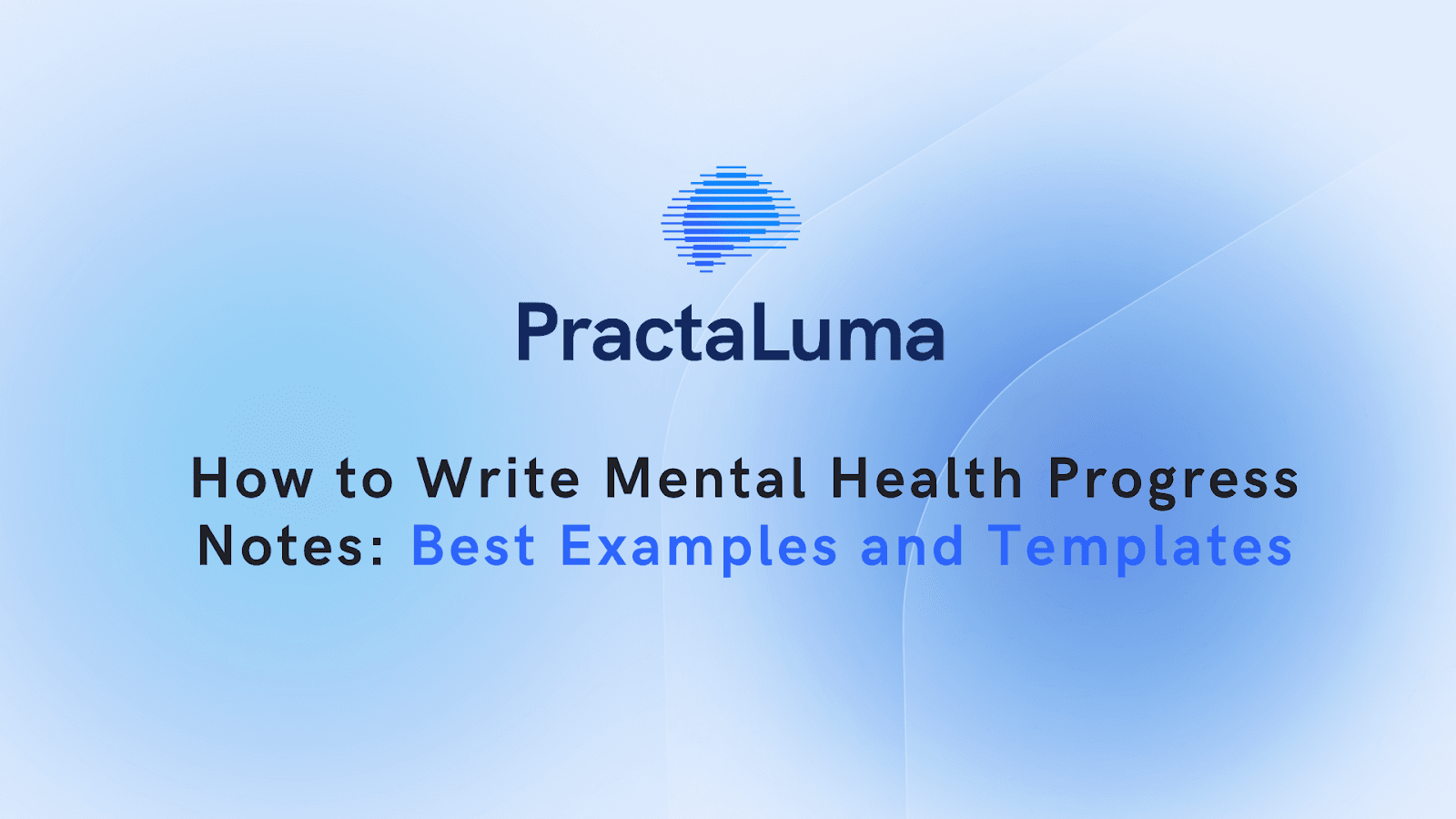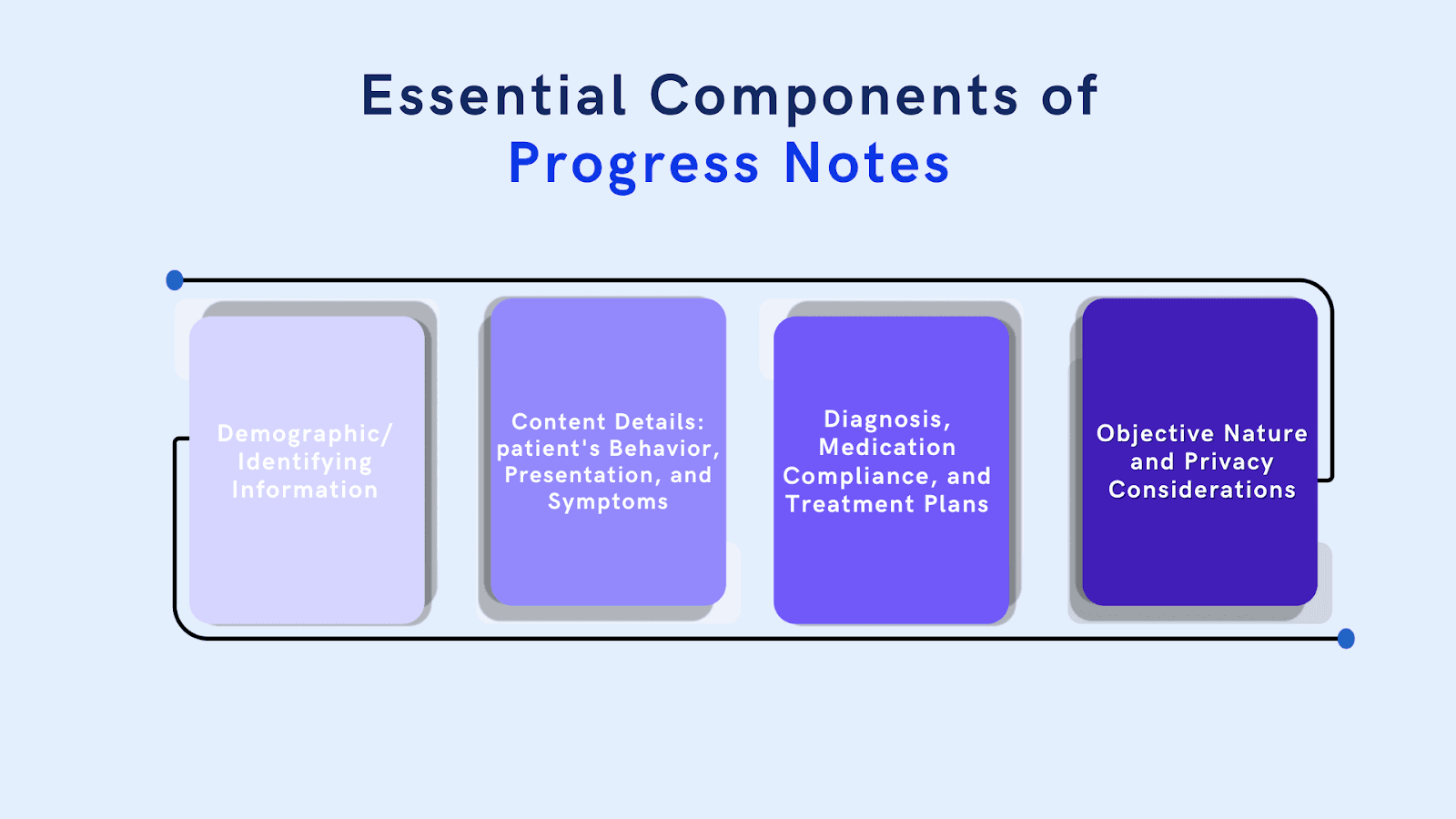
1 April 2025
How to Write Mental Health Progress Notes: Best Examples and Templates
Practical mental health progress notes capture fundamental therapeutic interactions and patient insights, helping professionals track progress and provide personalised care.
These notes document a patient's journey, ensure continuity of care, facilitate provider communication, and meet legal and ethical requirements. Whether you're an experienced practitioner or a beginner, mastering the art of clear, concise, and clinically relevant progress notes can feel overwhelming.
What are Mental Health Progress Notes?
Mental health progress notes are essential tools in clinical practice, helping maintain organisation, meet professional and legal obligations, and ensure optimal patient care. They document patient interactions, assessments, and treatment plans, supporting continuity of care, communication, and informed decision-making. Let’s find out how progress notes help you with the best clinical practice.
1. Document Session Details and Patient Condition
Progress notes are your way of tracking what happens during each session. They capture the patient’s condition, the interventions you used, and any updates on their mental health. These records give you a clear picture of the patient’s journey and guide your approach for future sessions.
2. Legal and Ethical Responsibilities
As a mental health professional, you must keep accurate and secure records. Progress notes protect you and your patient by ensuring transparency and compliance with laws and ethical guidelines. They’re not just helpful—they’re essential for maintaining professionalism.
3. Monitoring Patient Response and Well-Being
Progress notes also help you monitor how your patient is responding to treatment. Over time, you can spot patterns, track improvements, or identify areas that need more focus. This isn’t just about keeping records.
Understanding the role of progress notes sets the foundation for effective practice. Let us look at tips for writing clear, concise notes that work for you and your patients.
Standard Formats of Mental Health Progress Notes
Choosing the correct format for your progress notes can make documenting sessions more efficient and valuable. Here are three widely used options that keep things organised while meeting professional standards.
1. SOAP Note: Subjective, Objective, Assessment, Plan
SOAP notes are a classic choice. They break down into:
- Subjective: What the patient shares about their feelings or experiences.
- Objective: Observable facts, like body language or mood changes.
- Assessment: Your clinical impressions or diagnosis updates.
- Plan: Steps for future sessions or patient goals.
This structured format ensures every session is well-documented.
2. DAP Note: Data, Assessment, Plan
DAP notes simplify the process while staying comprehensive:
- Data: Key facts from the session, including patient treatments and behaviours.
- Assessment: Your interpretation of the data and its relevance to treatment.
- Plan: A roadmap for the next steps or follow-ups.
It’s a streamlined alternative for when time is tight.
3. BIRP Note: Behavior, Intervention, Response, Plan
BIRP notes focus on patient actions and your interventions:
- Behaviour: What the patient said or did not say during the session.
- Intervention: Techniques or strategies you used in response.
- Response: How the patient reacted or progressed.
- Plan: What comes next in treatment?
This format is excellent for tracking immediate impacts and planning.
Each format serves a purpose, depending on your style and the needs of your practice. Let us now look at how to make these notes concise yet detailed so you can stay productive while ensuring quality care.
Essential Components of Progress Notes

Progress notes aren’t just about jotting things down—they’re crucial to delivering quality care. To make them effective, there are key elements you need to include every time.
1. Demographic/Identifying Information
Start with the basics. Include the patient’s name, session date, and other relevant details to ensure the notes are tied to the right person. These identifiers set the foundation for clear and organised records.
2. Content Details: patient's Behavior, Presentation, and Symptoms
Describe what stood out during the session. Did the patient seem calm or agitated? Were there specific symptoms or behaviours that marked progress or setbacks? Capturing this information paints a picture of the session and helps track changes over time.
3. Diagnosis, Medication Compliance, and Treatment Plans
Progress notes should include updates on diagnoses, whether the patient is following their medication regimen, and any adjustments to treatment plans. These details keep you aligned with their overall care goals.
4. Objective Nature and Privacy Considerations
Keep it factual and professional. Avoid personal opinions or assumptions, and stick to observations and patient statements. Always ensure the notes are compliant with privacy standards to protect sensitive information.
By including these essential components, your progress notes become a reliable resource for you and your patient. Next, we’ll look at strategies to write notes more efficiently without sacrificing quality. Let’s dive into the details.
Effective Writing Strategies for Progress Notes

Writing progress notes can be a simple task. With the appropriate strategies, you can ensure they are efficient, accurate, and easily manageable.
1. Timing and Method of Note-Taking, Including Using EHR
The sooner you write your notes after a session, the better. Details are fresh in your mind, and you’re less likely to miss anything important. Electronic Health Records (EHR) systems can help streamline the process, offering templates and secure storage to keep your notes organised and accessible.
2. Importance of Conciseness and Structured Approach
Progress notes don’t need to be extended to be effective. Stick to key points and avoid unnecessary details. Using a structured format, like SOAP or DAP, helps keep your notes clear and ensures you cover all the essentials without overcomplicating things.
3. Inclusion of Relevant Information and Documentation Plans
Focus on what matters. Include observations, patient statements, and any updates to their treatment plan. This ensures your notes are meaningful and actionable for you and anyone involved in the patient's care.
With these strategies, writing progress notes becomes a smoother part of your routine.
Examples of Progress Notes
Seeing examples makes writing progress notes more approachable. Here are three examples using popular formats tailored to everyday mental health situations.
Example of Progress Notes (Case Scenario)
Case Scenario: Managing Chronic Pain in a Patient
Patient Information: A 45-year-old female with a history of chronic lower back pain is currently managed with a combination of physical therapy, pain medication, and lifestyle changes. The patient reports gradual improvement, but pain levels remain moderate.
Progress Note Example:
Date: November 28, 2024Session Type: Follow-up consultation for chronic pain management
Subjective: The patient reports that her pain levels have decreased from a 7/10 to a 5/10 in the past two weeks. She states she feels "less stiff" in the mornings but still experiences significant discomfort after prolonged sitting. The patient also mentions feeling fatigued after physical therapy sessions, but has continued performing home exercises.
Objective: The patient appeared slightly fatigued but could move without noticeable discomfort during the session—no signs of acute distress. The range of motion in the lower back has improved somewhat (an increase of 5 degrees in lumbar flexion). Pain level reported at 5/10 on the visual analog scale.
Assessment: Chronic lower back pain continues to improve, but the patient’s pain threshold is still moderate. Fatigue after therapy could be limiting her ability to engage fully in daily activities—no signs of new complications or issues related to her current medication regimen. The patient complies with the prescribed physical therapy and exercise plan.
Plan:
- Continue with the current physical therapy program and medication as prescribed.
- Adjust the home exercise regimen to include more frequent rest intervals to combat fatigue.
- Monitor pain levels, especially after physical activity, and follow up on any new issues.
- Schedule a follow-up in two weeks to reassess pain levels and adjust the treatment plan if necessary.
Discover AI-assisted progress note templates specifically designed for your practice.
Examples like these give you a framework to approach your progress notes confidently. Let’s cover tips to ensure your notes comply with professional and legal standards.
Integrating Progress Notes with Electronic Health Records (EHR)
Integrating progress notes with Electronic Health Records (EHR) can streamline your documentation process, improve organisation, and reduce errors. Here’s how EHR can benefit your practice:
- Legibility and Automated Processes:EHR systems eliminate the issues of deciphering handwritten notes, ensuring all documentation is legible. Automated features like reminders and pre-filled fields save time and reduce errors.
- Uploading Templates and Built-in Documentation:Many EHR platforms allow you to upload or create templates for formats like SOAP or BIRP. These templates help ensure consistency and cover all essential details in each note.
- Hybrid Approaches for Memory Aid and Session Guidance:Some professionals prefer to take quick notes during sessions and refine them later in the EHR. This approach helps capture real-time observations while benefiting from EHR features for final documentation and goal-setting.
Let us discuss some common pitfalls to avoid when documenting progress notes and how to keep your records top-notch.
Best Practices and Benefits
Writing progress notes isn't just about keeping records; it's about ensuring they’re done right. When you follow best practices, your notes transform from a simple task into a powerful tool that helps provide better care, enhances communication, and ensures legal and regulatory compliance. Below are some of the best practices to follow and their associated benefits:
Best Practices for Writing Progress Notes:
- Consistency and Accuracy: Ensure your notes are accurate and consistent. This includes recording every detail as it happened, avoiding vague language, and sticking to objective observations.
- Timeliness: Write your progress notes as soon as possible after a session. This ensures that the information remains fresh in your mind and is more accurate.
- Clarity and Specificity: Write your notes clearly and in a way others can easily understand. Avoid medical jargon when possible and ensure that any terms are precise.
- Patient-Centered Documentation: Focus on the patient’s needs, progress, and treatment goals. This ensures that the notes are meaningful and valuable for ongoing care.
- Confidentiality and Security: Follow proper procedures for storing and sharing patient information in compliance with HIPAA. Use secure systems to prevent unauthorised access to notes.
- Standardised Formats: Use standardised formats like SOAP (Subjective, Objective, Assessment, Plan), DAP (Data, Assessment, Plan), or BIRP (Behavior, Intervention, Response, Plan). These frameworks help ensure all essential information is included in your notes and maintain consistency across records.
- Legal and Regulatory Compliance: Ensure your notes adhere to legal and regulatory standards, particularly HIPAA, to avoid potential legal issues and protect patient privacy.
- Structured Documentation: Organize your notes in a structured way that highlights essential information. This makes it easier for others to follow and increases the effectiveness of care coordination.
Conclusion
Accurate progress notes aren’t just a professional obligation but a cornerstone of effective therapy. They help you track patient progress, ensure compliance with legal standards, and support the success of your treatment plans. Take the time to explore different templates and tools to find what works best for your practice.
Ready to simplify your documentation process? Practaluma offers tools and templates to make progress notes more straightforward and effective.
Begin optimising your workflow today; your patients will appreciate it.